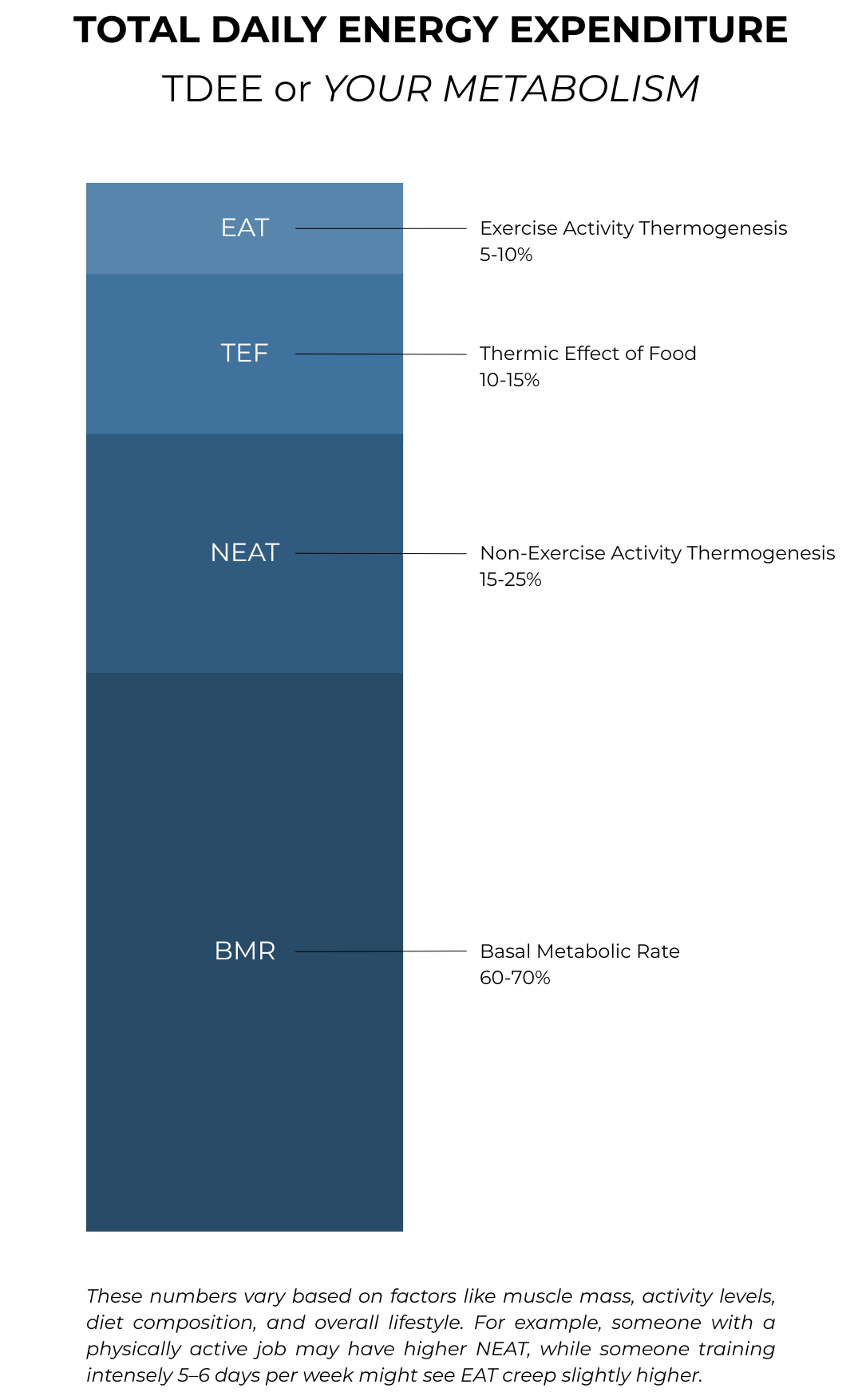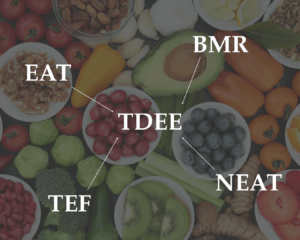What Really Happens to Your Metabolism After 30?
(It's Not What You Might Think!)
Think Your Metabolism Suddenly Started to Decline After 30? Think Again.
Most people blame any weight gain in their 30s and 40s on a “slowed” metabolism. Hate to break it to you, but this isn’t it. A study has found that metabolism doesn’t significantly decline until after age 60. So, if it’s not your biology, what gives? What happens to your metabolism?
What the Reseach Actually Shows
A massive 2021 study published in Science by Duke University and international collaborators analyzed data from over 6,400 individuals across 29 countries, ranging in age from 8 days to 95 years. Researchers measured total energy expenditure in real-world settings and were able to accurately assess how human metabolism changes across the lifespan. Here’s a quick overview of what they found:
From birth to age 1, your metabolic rate skyrockets. Infants burn calories at a rate nearly 50% higher than adults when adjusted for body size. This is the highest rate of metabolism you’ll experience in your entire life.
From age 1 to around 20, metabolism gradually declines. Contrary to the belief that teens have “unbeatable” metabolisms, it’s actually a downward slope from infancy, though it is still relatively high due to growth and high activity levels.
From age 20 to 60, total energy expenditure holds remarkably steady. When adjusted for fat-free mass (lean mass), there’s no significant decline in metabolism during these decades, even through pregnancy, menopause, and middle age. Yep.
After age 60, metabolism begins to gradually decline at a rate of about 0.7% per year, primarily due to the loss of lean body mass and organ function.
This research overturns decades of assumptions that your metabolic rate begins dropping in your 30s or 40s, especially for women. Instead, it points to changes in lifestyle, movement, and body composition as the real culprits behind slowed fat loss or weight gain in adulthood.
So if you’ve said that , “I hit 30 and everything changed,” what’s really happening is not a metabolic cliff, but a quiet accumulation of habit shifts.
Let’s breakdown what’s really going on, starting with TDEE.
What Is TDEE?

TDEE stands for Total Daily Energy Expenditure. It’s the total amount of energy (calories) your body burns in a day. TDEE has four components:
1. Basal Metabolic Rate (BMR)
The number of calories your body needs to maintain basic functions like breathing, cellular repair, and keeping your organs functioning. This makes up the largest portion of your TDEE. around 60 to 70 percent
2. Non-Exercise Activity Thermogenesis (NEAT)
This includes all the little movements you do during the day: walking, cleaning, fidgeting, cooking, playing with your kids. NEAT can vary dramatically from person to person and plays a significant role in energy balance.
3. Thermic Effect of Food (TEF)
Your body uses energy to digest, absorb, and process all of the food you eat. Protein has the highest thermic effect. So all of that talk about consuming more protein? It’s more than adding lean mass because higher protein meals will increase your TDEE.
4. Exercise Activity Thermogenesis (EAT)
This is what you burn during traditional, intentional workouts. Contrary to popular belief, this makes up the smallest slice of the TDEE pie for most people, at around 5 to 10 percent.
So, What Changes in Your 30s and 40s?
Your metabolism didn’t “crash” at 30, but your lifestyle likely did change in small, compounding ways. Think back to when you were younger…
You were constantly on the move: walking to class across campus, lugging around a backpack, meeting up with friends, riding your bike, playing a school or club sport, or even just fidgeting while studying. Movement was built into your day without thinking about it, even if you weren’t working out.
Then came full-time work.
Now you spend most of your day sitting at a desk, in your car, during meetings. Add a growing list of responsibilities: a demanding job, family schedules, household logistics. Your time is limited, energy is split, and convenience takes over.
So, you reach for the quickest food options, skip meals, or eat while multitasking. This food is usually higher in refined carbs and fats. You sleep less, stress more, and workouts start slipping through the cracks.
Let’s compare this to the four components of TDEE:
BMR: remains stable through your 30s and 40s unless there’s significant muscle loss
NEAT: declines because you sit more and are less active overall
TEF: may drop if your diet shifts toward ultra-processed, or quick meals low in protein and fiber
EAT: becomes inconsistent due to stress, fatigue, or lack of energy
You feel off. Your body changes and you feel stuck. So, you decide to “get back on track.” And what do you reach for? The same workouts, meal plans, or habits that worked in your 20s.
Except… your life looks nothing like it did then. That’s where the disconnect comes up for most people. It’s not that your body is broken or a switch has flipped, the old strategies no longer match your current reality.
The good news? You can improve it.
How to Improve Your TDEE (Without Burning Out)
Here’s how to support and improve each piece of the TDEE puzzle:
1. Support BMR by Building and Maintaining Muscle
Muscle is metabolically active tissue. Strength training and protein intake help you retain lean mass as you age. This alone can make a noticeable difference in how your body feels and functions. You can read more about that for women, here.
2. Increase NEAT by Adding More Movement into Your Daily Life
Take phone calls standing. Walk after each meal. Carry your groceries to a parking spot further away from the door. Stretch during TV time. Increase your step count. While 8-10k steps per day are optimal, if you’re sedentary, start out with adding 1-2k more.
3. Boost TEF by Prioritizing Protein
No, you’re not going to stop hearing about protein any time soon. Aim for at least 25 to 30 grams of protein per meal. This helps keep you full, supports recovery, and raises the thermic effect of each meal just a bit.
4. Make EAT Effective, not Excessive
Workouts should be smart, not a punishment or haze fest. Focus on compound lifts, progressive overload, and… rest days. More is not better, better is better. You can check out some of my available training programs, here.
Why Just Adding Training Alone Isn’t the Answer
Exercise is essential, but it’s only a small piece of the puzzle. If you’re training hard and consistently, but:
sitting for 10 to 12+ hours a day
always eating in a rush or skipping meals
sleeping poorly and running on stress
ignoring your recovery
…then your results will stall, no matter how good your program is. A high-quality strength training plan paired with high-protein nutrition, daily movement, and better recovery habits is how you truly rebuild your metabolism and your healthiest again.
The Bottom Line
By now, you get it. You didn’t ruin your metabolism and it didn’t suddenly crash at 30.
What changed was your lifestyle, and that means it’s something you can shift again, this time in a positive direction with intention. However, understanding why things changed doesn’t automatically make it easier to fix.
Let’s be honest for a second… when your schedule is packed, your energy is drained, and everyone needs something from you, finding the time to workout, go for a walk, prep a balanced meal, and get to bed on time feels like a fantasy, right?
You probably want to take better care of yourself. You know the basics: move more, eat better, sleep well. Check. The how? That’s the hard part.
How do you decide what to focus on first? How do you build a realistic routine when your days already feel maxed out? How do you actually make this sustainable instead of swinging between extremes?
That’s where coaching comes in.
I don’t just give you a list of to-do’s or a random one-size-fits-all plan. I help you figure out what actually fits into your current life and what needs to shift so you can finally feel better in your body again. We piece together a personalized plan. We troubleshoot together. We adjust in real time, because it is normal to have to adjust and pivot.
The puzzle can be solved and you don’t have to do it alone.
If you’re ready to rebuild your foundation with structure, support, and a clear plan… I’m here to help.
Reference
Pontzer, H., Yamada, Y., Sagayama, H., Ainslie, P. N., Andersen, L. F., Anderson, L. J., … & Westerterp, K. R. (2021). Daily energy expenditure through the human life course. Science, 373(6556), 808–812. https://doi.org/10.1126/science.abe5017



